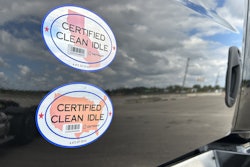Through various filters and sorting tools, dispatch software systems can synthesize hundreds of details about drivers, equipment and loads onto one screen. Using the logical, left-side reasoning of the human brain, dispatchers and load planners can match these often competing variables.
But recently, software providers are tapping into the “right hemisphere” with more graphical and visual tools to help decision processes become more intuitive for end users: Color-coding exceptions is one such example. John Miller, operations manager for Excel Transportation, has more than two years’ experience with McLeod’s LoadMaster dispatch system. Excel Transportation is a 400-truck private fleet for Excel Corp., a worldwide provider of beef and pork products. Miller says a LoadMaster feature that color-codes drivers according to their status throughout the day has helped Excel Transportation’s dispatchers and load planners make better, faster decisions.
If a driver has a potential conflict with a load – such as home time, vacation time or insufficient hours of service – his status on the screen changes from white to red, Miller says. Excel’s load planners also see real-time status of drivers through integration of the LoadMaster system with the carrier’s satellite tracking and mobile communications system. Drivers confirm receipt of load assignments and send macros (small, pre-defined messages) as they arrive to load, get loaded, depart and get empty, Miller says.
When a driver issues an “empty call,” he changes color on the screen, alerting dispatchers to assign a load if one is not assigned already. The McLeod system also calculates the distance to delivery and, through real-time tracking data, will change the color of a truck or driver on the screen if the system calculates a load will be late, Miller says.
“We are able to view everything on one screen,” he says.
A more recent enhancement to the LoadMaster system is map integration, says Tom McLeod, president of McLeod Software. Trucks, loads, drivers and other items are represented by icons that can change color to show if a truck is on time or sitting empty. For example, a load icon is color-coded according to status such as a late pickup or pre-assigned load, McLeod says. Users can pan and zoom to locations where a truck is going to be available and click an icon to see more detailed information.
Maddocks Systems’ TruckMate 4 Windows also recently introduced an optional map-based application to visually plot current and future location of vehicles/drivers. By pulling up a map of where everyone is going to be next Friday, a dispatcher could overlay the available loads in the area and the number of drivers that will be nearby to pre-plan pickups, says Lee Hamilton, Maddocks’ vice president of business development.
In addition to its map view, Maddocks recently added a calendar-based dispatch application. On the top of the screen, a dispatcher can view available loads. On the bottom, he sees each driver’s workweek in a calendar view, with the loads that each driver is working on or has been assigned, arranged in chronological order. The calendar view is helpful for a dispatcher to identify dwell time – the time between a delivery appointment and the next pickup appointment, Hamilton says.
The dispatcher can drag and drop loads from the top section into the bottom section to perform a match. When making matches, fleets can set up “flags” for various events that notify dispatchers if loads do not work because a delivery time cannot be met or if a driver’s available hours of service aren’t compatible, Hamilton says.
TMW Systems recently launched a calendar-based dispatch module called Visual Dispatch Plus (VDP) for its TMW Suite. Transport National was one of the first TMW customers to use VDP; the tool has reduced the steps in the dispatch process from four to two, says Matt Zeigler, sales and marketing director of the 60-truck, Oak Creek, Wis.-based carrier. The first step is to “drag and drop” loads onto a calendar view of its drivers’ workweeks; the second step is to assign a trailer.
To notify dispatchers of exceptions or scheduling conflicts, VDP colors blocks in drivers’ schedules with a “big red line” that tells dispatchers not to drop a load if a driver is unavailable because of vacation time or an expired medical card or driver’s license, Zeigler says.
“We’re making better decisions,” he says. “It is easier to see the drivers available and the loads available. We don’t have as many surprises pop up.”
Transport National, which specializes in over-dimensional freight, also uses VDP’s calendar-based view to manage its permit process. When a dispatcher drops a load onto a driver’s schedule, the block of his schedule becomes yellow to show he is pre-planned. If the load requires a permit, the block changes to orange. The permit department sees the orange block and clicks on it to get the information necessary to generate a permit. The department then changes the color back to yellow once it completes the paperwork. Zeigler and other managers then can be alerted if the load to New Jersey has not been given a permit.
“Sometimes they forget to change color, but at least I’m asking the question,” Zeigler says.
When compared to truckload, a dispatcher or load planner for a less-than-truckload or multi-stop operation takes into account more details on a daily basis. Therefore, a week-by-week calendar or map-based view of its operation may not provide visibility into its most important variables – such as the number of stops and time between them – to look for excess capacity.
Profit Tools, a trucking software provider specializing in products for multi-mode operations, recently added a tool to its system that allows users to expand their screen into a multi-day itinerary, allowing multi-mode and LTL customers an expanded view of their operations. When planning the next day’s itinerary, users quickly can scroll from one day to the next, whereas in previous versions they had to click from one day to the next, says Quentin Eastman, Profit Tools’ director of marketing.
Each dispatch software system may have a unique look and feel, but when it comes to their strategies to present better information to the end user, it is becoming commonplace to use pictures instead of columns or rows of data. After all, a picture is worth more than just a thousand words.









